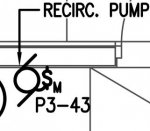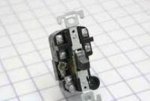mstrlucky74
Senior Member
- Location
- NJ
Have never come across motor switches located remotely on a wall like this. They seem to be showing regular toggle type switches and not thermal overload type for the exhaust fans. As you can see in the other pic for another motor type they do show overload type. The only thing I can think of is the exhaust fan has some sort of means of disconnect internally( they don't show anything). Can they exhaust fan switches be regular toggle type as they show and not thermal overload type? Thanks.




